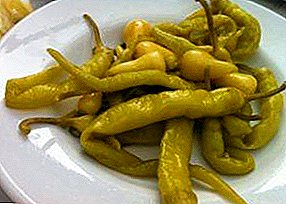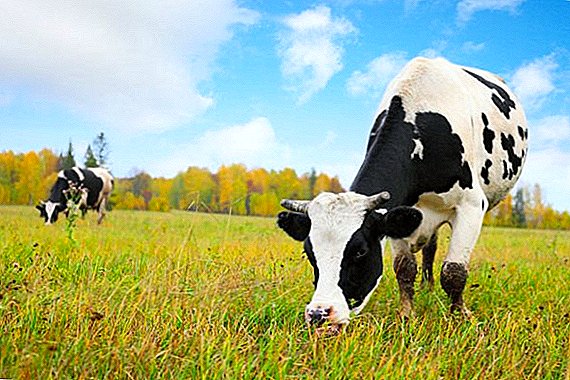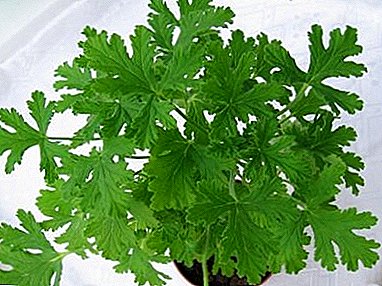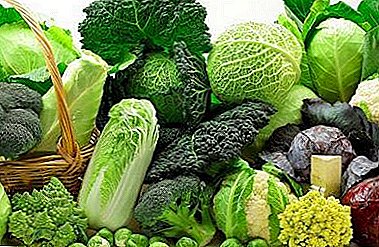
Cabbage is an agricultural plant grown on most summer cottages. Vegetable ranks second in frequency of human consumption after potatoes. The plant is unpretentious and adapts to any soil, with the exception of the desert and the Far North. Cabbage has healing properties and contains a considerable amount of fiber, fats, vitamins, microelements that enrich the human immune system with iron, potassium, magnesium, calcium and folic acid.
By consuming 200 grams of cabbage daily, you can avoid vitamin C deficiency, ensure the prevention of colds and get a daily rate of fiber, which stimulates digestion. Other useful substances in cabbage are phosphorus, calcium, potassium, chlorine, phosphorus and sulfur, as well as volatile production of vitamins and vitamins, among which vitamin U deserves special attention, which cannot be synthesized in the body on its own.
Nutrients and healing properties
Cabbage - a storehouse of vitamin and mineral complexes, per 100 grams of cabbage cabbage representative of the cruciferous family accounts for:
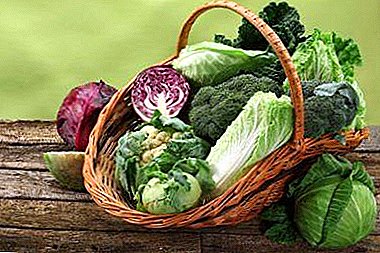 0.5 to 0.9% fiber pigments;
0.5 to 0.9% fiber pigments;- up to 1.8% protein;
- from 11-52.7 mg - vitamin C;
- 0.04 mg carotene;
- a complex of vitamins B1 and B2, B3, B4, B6, B7;
- 7 mineral substances in mg equivalent: potassium - 230; Ca — 70; sodium / magnesium - 16.18; P / Fe - 31 / 1.2.
Cabbage juice is recommended to drink for people with diseases of the gastrointestinal tract, its expectorant properties allow you to quickly cure coughs and colds. Cabbage prevents fatty degeneration of the liver and normalizes metabolism.
The chemical composition of the remaining species is briefly presented in the tables below.
The main chemical composition in percentage ratio.
| Type of cabbage | % per 100 g wet weight Starch; cellulose; raw protein |
| Red Knot | 0.5; to 0.9; up to 2 |
| Savoy | 0.1; up to 1; to 2.2 |
| Brussels | 0.5; up to 1.7; to 5.5 |
| Decorative | 0.5; up to 1.8; up to 3.6 |
| Colored | 0.5; up to 1.1; up to 2.5 |
| Kohlrabi | 0.5; up to 1.6; to 2.8 |
Mineral elements in 100 grams of 7 names of cabbage.
| Type of cabbage name | Mg of minerals in 100 g Sodium; K; calcium; magnesium; P / Fe |
| Red Knot | 4; 302; 53; 16; 32/0.6 |
| Savoy | 8; 305; 150; 0; 60/2 |
| Brussels | 7; 500; 40; 40; 110/1.3 |
| Decorative | 14; 350; 200; 35; 60/3.4 |
| Colored | 10; 210; 60; 17; 51/1.4 |
| Kohlrabi | 20; 370; 52; 30; 50/1.5 |
The vitamin composition of each type of cabbage in 100 grams.
| Title | Mg of vitamins in 100 g C; BUT; B1; B2; B6; PP |
| Red Knot | 99.1; up to 0.2; 0.05; 0.05; 0.23; 0.40 |
| Savoy | 60.7; up to 0.4; 0; 0; 0.14; 0 |
| Brussels | Up to 207.7; up to 0.5; 0.13; 0.15; 0.28; 0.70 |
| Decorative | 150; 5; 0.18; 0.01; 0; 0 |
| Colored | Up to 93; up to 0.2; 0.10; 0.08; 0.16; 0.60 |
| Kohlrabi | 67; up to 0.06; 0.08; 0.10; 0; 0.90 |
Each component plays a huge role for the functionality of the body:
 Cellulose performs the function of cleansing the body of toxins and trace elements that block vessels.
Cellulose performs the function of cleansing the body of toxins and trace elements that block vessels.- Vitamin C - controls the oxidative processes of the gastrointestinal tract and strengthens bone tissue, blood vessels.
- Vitamin component of group A able to normalize the work of metabolic and biological processes (the formation, structure of the teeth and the accumulation of fat).
- Vitamin B Group - increase the growth of nails and hair; stimulates the brain and a good mood, minimize the level of fat in the blood to normal.
- Mineral components: Na; K; Ca; Mg; Fe / PP - regenerate damaged gastrointestinal ulcer and strengthen the CSN, form protein.
We offer to watch a video about the benefits of cabbage for the human body:
Which is better, fresh or cooked?
Cabbage is a versatile vegetable, it is used for cooking first and second courses, cold snacks and flour products. But, despite its versatility, each method of cooking dishes in different ways saves the level of utility of the cabbage components.
Vitamins and mineral complexes available in cabbage can be saved at 100%, if the vegetable is not subjected to a strong heat treatment. Fresh and sauerkraut retain all the beneficial properties of the vegetable, have a beneficial effect on the gastrointestinal tract of patients with dysbacteriosis and miasmatic processes, and its use in fresh or fermented form helps restore the functions of the liver and heart.
But cooking cabbage by boiling or stewing does not save one hundred percent utilitydue to its processing by high temperatures. But it is these cooking methods that allow the vegetable to be better absorbed in the human body without irritating the digestive system.
Cabbage that has undergone heat treatment is recommended for use by people who regularly have a violation of intestinal motility.
The benefits of its various types for human health
The diversity of representatives of the cruciferous family allows you to take care of the health of an adult and children. Below is a brief selection of types of cabbage that are suitable for different age categories of people.
What is the child's body for?
 In the diet of children indispensable product - cauliflower or broccoli. These varieties of the cruciferous family do not cause allergic reactions, are easily absorbed by the children's body and are recommended for use from early childhood (the period of prikorma). The benefits of vegetables are that they contain:
In the diet of children indispensable product - cauliflower or broccoli. These varieties of the cruciferous family do not cause allergic reactions, are easily absorbed by the children's body and are recommended for use from early childhood (the period of prikorma). The benefits of vegetables are that they contain:
- vitamins (C, B1, B2, PP, E, A);
- mineral components (Mg, K, Ca, Fe).
What is useful for women / girls
White cabbage - a familiar product of the daily diet. But the use of the vegetable is not limited to the framework of cooking, girls and women have found it used in the field of cosmetology and nutrition.
The benefits of white cabbage for women are:
- improve metabolism, thereby reducing weight;
- antioxidant activity of vegetables, which minimizes the risk of malignant tumors;
- the ability to affect the reproductive function of the body;
- increasing the tone of the skin;
- strengthening the immune protective barrier;
- removal of excess water from the body, which reduces weight and reduces puffiness.
There is another type of cabbage, which is useful in the use for the female body - broccoli.
Broccoli nutrients are capable of:
- block the development of breast cancer;
- rejuvenate the body from the inside;
- contribute to the prevention of diseases of the joints.
Eating broccoli up to 4 times a week, a woman in the shortest time will restore the natural glow of the skin and even the tone of her face.
How does it affect men?
Cabbage for men, not only a snack, but also a means of correcting their own health, bypassing drug treatment. Eating a pickled cruciferous product, a man strengthens the central nervous system and heart vessels. Moreover, regular intake of sauerkraut will allow a man to maintain male power for many years.
Red, Peking and Brussels sprouts affect the male body in this way.:
 impede infertility;
impede infertility;- strengthen the work of the brain;
- block the development of malignant tumors;
- reduce weight.
Broccoli and cauliflower became the favorites of medical research in the field of men's health. It has been proven in practice that eating these types of cabbage minimizes the risk of developing prostate gland diseases in men and increases stamina during sexual intercourse, and has a firming effect on the body.
Use of various parts of the plant:
Cabbage is a vegetable rich in nutrients. All parts of the fruit are marked edible (leaves, head, stalks and even its juice). The use of each component of cabbage in any form is good for health.
Head of cab
Actually it is a head of cabbage and is used in food. If we talk about cabbage and red cabbage, then their early varieties have the most tender leaves, they are poorly stored, but they are very tasty fresh. Cabbage with an average maturity is well treatable, it is successfully used for cooking. Well, later varieties are ideal for long-term storage and pickling.
It should be noted that with proper storage, cabbages do not lose their taste and useful properties until mid-winter and longer.
In other types of cabbage kochanchiki may look different, but the essence of this does not change.
Stump
Cabbage stalk is a treat of early childhood. But its usefulness is debated. On the one hand, it is a storehouse of fetal nutrients. On the other hand, it can accumulate harmful substances, nitrates, fertilizers, and so on. Knowledgeable people claim that it is very easy to recognize harmful cabbage, by cutting the stalk. It will not be pure white, but with dark or pinkish spots.
The stalk is often used in traditional medicine for the preparation of a decoction, the purpose of which is to fight cancer cells. For the preparation of folk medicine will need:
- finely chopped stalk;
- sunflower oil;
- leaves of thistle;
- boiling water.
The decoction of the stalk must be wrapped and left to infuse for more than 2 hours, after which you should drain the liquid and start taking.
Leaves
The benefits of cabbage leaves for health can be seen in practice, for example, applying compresses to a sore spot. The scheme of action is:
- apply fresh cabbage leaf to the sore spot;
- biologically active components of cabbage penetrate into the tissue;
- reaching it, relieve pain and inflammation.
 Compresses can be applied:
Compresses can be applied:
- with headaches on the occipital and frontal part;
- cheeks for diseases of the oral cavity and external edema;
- on the neck in front of respiratory diseases: laryngitis, tonsillitis, inflammation of the lymph nodes;
- on the neck from the back with the complex treatment of cervical neuritis;
- on the chest in diseases of the cardiovascular system, lungs, bronchi;
- on the abdominal cavity and pelvic region with diseases: prostatitis, cystitis, ovaries, liver, pancreas.
It is easy to determine the effectiveness of treatment with compresses, as soon as the LHC gets to the place of inflammation and pain, the cabbage acquires a specific smell.
The juice
Benefits from oral administration of freshly squeezed cabbage juice:
- helps immunity resist diseases;
- prevents premature cell aging;
- improves blood clotting;
- forms bone tissue;
- promotes rapid treatment of respiratory diseases;
- stabilizes the work of the kidneys.
We offer to watch a video about the benefits of cabbage juice:
Contraindications
Given the huge range of useful properties of vegetables, it is necessary to note the other side of the issue, namely, contraindications for the use of cabbage.
White cabbage is forbidden to eat people:
- with increased acidity of the gastric tract;
- patients diagnosed with colitis and enteritis;
- children under 2 years.
Kohlrabi is not recommended for use in people who have been identified:
- gout;
- stones in the kidneys;
- thyroid dysfunction.
Red cabbage should be eaten with care.:
 people prone to allergic reactions;
people prone to allergic reactions;- having a predisposition to bloating and indigestion;
- pregnant with individual intolerance.
Brussels sprouts - the choice of gourmets. It has a huge range of useful properties, however, despite this, it is contraindicated to use in the diet of people prone:
- to indigestion;
- with thyroid problems.
As for cauliflower and broccoli, then, despite their leadership, they can be harmful:
- patients with pancreatic problems;
- people diagnosed with gastritis and high acidity;
- people who are allergic;
- patients with a diagnosis of weak intestinal tone.
Is it harmful to the intestines: can one eat a vegetable at night or not?
Due to the sufficient content of fiber and mineral components, taking cabbage at night can cause:
- heaviness, bloating;
- excessive gas formation;
- peristalsis.
Harm
What is harmful cabbage?
Excessive consumption may:
- reduce the amount of seed in men;
- cause defects in the liver and kidneys due to excess salt, when consumed sauerkraut.
It is necessary to control the daily rate of consumption of cabbage for people:
- with renal insufficiency;
- with gall bladder problems;
- with the running form of an ulcer.
How to choose in the store?
 Choose a quality vegetable can be based on its detailed visual inspection. Algorithm of actions when choosing cabbage:
Choose a quality vegetable can be based on its detailed visual inspection. Algorithm of actions when choosing cabbage:
- Analysis of the leaves - they must meet two parameters: freshness and green.
- The heading should be dense and white on the cut.
When pressing on the vegetable should not show deformation and the optimum weight of the fruit should be 1 kg.
When choosing any kind of cabbage, be careful. Its appearance should be presentable, without sharp odors and with fresh outer leaves.
Which kind is better?
What kind of cabbage is more useful? Each cruciferous vegetable has its own beneficial properties., but not everyone is suitable for all categories of people, from babies to elderly people. But the body of each of us needs to obtain the necessary amount of vitamins and minerals daily.
Broccoli is a type of cabbage suitable for different age groups of people and even babies from the age of 4-5 months.
It has a good effect on the development of the child's body, helps to maintain the natural beauty of women and girls, and also gives men strength. This kind of clear leader for the following reasons:
- easy digestibility in comparison with other types of cabbage;
- lack of irritation of the gastrointestinal tract, which allows the product to be eaten by people who have been diagnosed with non-severe degrees of diseases of the gastrointestinal tract;
- save the maximum number of useful items for any processing;
- huge content of vitamin C.
We offer to look at the video, what kind of cabbage is better - Chinese or white:
We offer to watch a video about which kind of cabbage is better - cauliflower or broccoli:
So, it turns out that cabbage is a very useful vegetable for daily consumption. It helps to get rid of weakness, lethargy, fatigue, problems with the digestive tract and the immune system. Cabbage is successfully used both in the field of traditional medicine and in the fields of cosmetology, dietetics, and traditional medicine.


 0.5 to 0.9% fiber pigments;
0.5 to 0.9% fiber pigments; Cellulose performs the function of cleansing the body of toxins and trace elements that block vessels.
Cellulose performs the function of cleansing the body of toxins and trace elements that block vessels. impede infertility;
impede infertility; people prone to allergic reactions;
people prone to allergic reactions;


